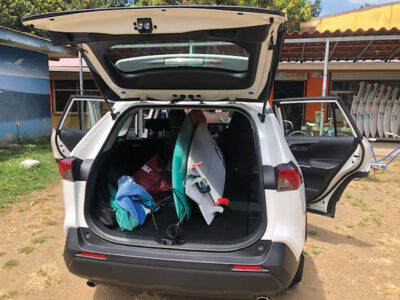How to Plan a Successful Surf Trip – Part 2
 In the last issue, I explained the first of many factors to consider when planning a Costa Rica surf vacation—finding the best time of year to go based on what type of waves you are looking for. In this article I will discuss whether to bring boards or rent them while you are there. Some points to consider are where you are going, what type of boards you need, what are the airlines going to charge you, and the convenience of each option.
In the last issue, I explained the first of many factors to consider when planning a Costa Rica surf vacation—finding the best time of year to go based on what type of waves you are looking for. In this article I will discuss whether to bring boards or rent them while you are there. Some points to consider are where you are going, what type of boards you need, what are the airlines going to charge you, and the convenience of each option.
 Some beach towns have a dozen surf shops (Tamarindo) while others have only one (Pavones – Sea Kings Surf Shop). Nosara has a half dozen places to rent boards, my favorite being Coconut Harry’s. Santa Teresa has Denga Surf Shop with a decent selection of long and short boards, but they are quite used. Manuel Antonio has some board rentals on the beach, but they are mostly beat up. Manuel Antonio Surf School has a few nicer long and fun boards to rent, but supply is limited. The Caribbean side has two places to rent boards in Puerto Viejo, and on the beach in Playa Cocles.
Some beach towns have a dozen surf shops (Tamarindo) while others have only one (Pavones – Sea Kings Surf Shop). Nosara has a half dozen places to rent boards, my favorite being Coconut Harry’s. Santa Teresa has Denga Surf Shop with a decent selection of long and short boards, but they are quite used. Manuel Antonio has some board rentals on the beach, but they are mostly beat up. Manuel Antonio Surf School has a few nicer long and fun boards to rent, but supply is limited. The Caribbean side has two places to rent boards in Puerto Viejo, and on the beach in Playa Cocles.
So, if you are a beginner surfer then these locations will have a sufficient longboard to ride. There are options for soft tops and hard top surfboards at many spots, and at this stage in your surfing progression you just want to catch waves and lugging your longboard from home may not be worth the hassle. If you are an advanced surfer though, you may want to bring the boards you ride at home since you know how they perform and you may not find a similar board at even the bigger surf towns of Jaco, Nosara, and Tamarindo. And if the waves are too small or too big, you could always find a board to rent (or buy used) to fit the conditions. There are a few Facebook groups that buy and sell surfboards in Costa Rica.
When I travel with boards, I have my board-bag, a suitcase, and a backpack. It can be a lot to lug around, especially if I bring 2 or 3 boards based on where I’m going to surf. I do not want to be at Pavones on a perfect double overhead plus day and be undergunned. Lately many airlines have been more favorable to surfers, allowing them to count the board-bag as their first checked bag and others are only charging $30-75 each way for a board-bag. However, airlines like JetBlue charge $100 per board each way. And if you are traveling from South America, Europe, or farther then the airlines may tack on additional fees. I check WaveTribe.com’s annual boardbag fee guide to keep track of what they are currently charging. If a board rental is $15-20/day and your board bag fee is $300 roundtrip, you can see the benefit of renting a board, or buying a used one and then selling it back to the shop. One other factor is the possibility that your boards are damaged during the flight.
In the end it comes down to convenience. If you have your boards with you then you don’t need to worry about finding the right board to rent. Or you might be on a long trip around the country where you are only surfing a few days of it, and so may just want to rent one while you are on the beach and not have to squeeze your board-bag into every place you are staying. If you are coming on a surf trip, then plan ahead. Check the forecast so you have a good idea of wave size. And then based on your wave riding experience, decide if it’s okay to travel light and pick up a board to rent while in Costa Rica or bring your own. Personally, I leave my boards at home and when I travel south I stop at Carton Surfboards in Jaco, who has newer, quality boards shaped for the waves that break in Costa Rica. And if I’m traveling to the north Pacific I’ll stop in Tamarindo and find the right board to rent before heading to a more remote break. And if I’m going to the Caribbean I’ll bring my own boards since there are few quality boards to rent there and it’s possible I might break one surfing the pounding beach and reef breaks.
The next article will discuss how to maximize your time surfing while you are visiting Costa Rica.
Feel free to contact me at [email protected] or message me on Instagram @crsurf.
